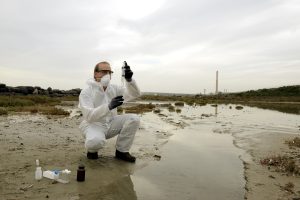Soil Contamination in the United States: Recent News
Written by Cooper & Friedman PLLC on April 18, 2017
 An industrialized society can also mean a contaminated one. The massive acceptance of industrialization in the United States has in turn led to increased levels of pollution. Soil contamination is a form of land degradation caused by human-made chemicals. These chemicals are unnatural to the land. They can have many adverse effects not only on the environment, but those living in or near the contaminated areas.
An industrialized society can also mean a contaminated one. The massive acceptance of industrialization in the United States has in turn led to increased levels of pollution. Soil contamination is a form of land degradation caused by human-made chemicals. These chemicals are unnatural to the land. They can have many adverse effects not only on the environment, but those living in or near the contaminated areas.
According to the Environmental Protection Agency, there are three variants of soil contamination:
- Sites contaminated by improper handling or disposal of toxic and hazardous materials and wastes
- Areas where toxic materials may have been deposited as a result of natural disasters or acts of terror
- Locations where improper handling or accidents resulted in the release of toxic or hazardous materials that are not wastes
Most commonly the toxins enter the land as a result of accidents, or improper handling and discarding of wastes. Through the Comprehensive Environmental Response, Compensation, and Liability Act (Superfund) of 1980, the EPA has enacted laws. These laws aid in cleaning up “uncontrolled or abandoned hazardous-waste sites as well as accidents, spills, and other emergency releases […] into the environment.” With the Superfund, the EPA is allowed to seek out any parties responsible for contamination and ensure their assistance in the recovery of the land.
Recently, there have been cases across the country that touch on this issue of soil contamination. The responsibility of the EPA has also become a concern.
Summaries of three recent news articles related to instances of soil pollution in the United States follow:
Soil Contamination Case #1
Tennessee- March 20
Near the University of Memphis, Sherri Schmidt owns and operates an art-supply store. She became sustained a respiratory illness after years of work and contacted state environmental regulators. After an investigation, the property was included in the National Priority List for attention from the federal Superfund. The government investigation discovered the soil, groundwater and indoor air at the property were contaminated with etrachloroethylene, a dry-cleaning solvent also known as perchloroethylene, or simply “perc”. This toxin is linked to neurological, liver and kidney problems that could lead to cancer. The site was formerly inhabited by a dry-cleaning store.
After the federal investigation, the building was demolished and the soil beneath was examined. The toxin was found all throughout the land, and some especially high levels were noted. The soil has been replaced. However, the EPA plans to keep an eye on the area and “conduct a remedial investigation and feasibility study that will assess threats to human health and the environment.”
Soil Contamination Case #2
Montana – March 27
An EPA Superfund is investigating the closed Columbia Falls Aluminum Company in Kalispell, Montana. On March 27, they released a 7,300-page report on the environmental integrity of the area. The report detailed, among other findings, 78 percent of soil samples contained cyanide and 98 percent contained fluoride. While none of the toxins have reached drinking water, the article references multiple locals who are concerned for their safety. The project manager for the investigation said that this report only concludes phase one of the investigation and only by 2021, when they plan to have completed the data collection, will they be able to embark on the process of cleaning up the area.
Soil Contamination Case #3
New Jersey – March 27
On Monday, March 27, the New Jersey Supreme Court ruled the state won’t be held responsible for part of an $80 million cleanup along Raritan Bay. In 2014, the EPA designated the cleanup project to NL industries. The company however, took legal action against the state claiming they knew the contaminated soil was being used to build a seawall along the Old Bridge Township in the 1970s. In the majority opinion, Justice Barry Albin wrote, “a private party cannot seek contribution from the State when the State has joint responsibility for a pre-Spill Act discharge. That interpretation leads to the absurd result that when the State and a private party are both responsible for a toxic discharge, the private party is on the hook for the entire cleanup cost.”
The “Spill-Act,” or the Comprehensive Environmental Response, Compensation and Liability Act, Justice Albin references in the opinion was passed in 1980, ten years after the initial contamination took place. NL Industries’ attorney, Christopher Gibson said he wasn’t satisfied with the court’s ruling. He said it blurs the line of responsibility in pollution cases such as this. “One of the things we’ve taken somewhat as an article of faith is that anyone who contaminates the land is responsible for its remediation,” Gibson said. “I always thought what the Spill Act did was make that equally true if you were a municipality, the New Jersey Department of Environmental Protection or if you were a chemical company.”
Contact Cooper & Friedman
If you believe that you or someone you know may be suffering from any adverse effects of environmental contamination including soil contamination in Kentucky or Southern Indiana, do not hesitate to seek out legal guidance and assistance. Cooper & Friedman offers free consultations with an experienced attorney in cases related to environmental pollution. Call (502) 459-7555 to set up your consultation today.

